Hakone is a popular day trip from Tokyo or an interesting short-stay option. For visitors who want an onsen experience while in Japan but don’t have the time to travel further afield, it’s easily accessible in Hakone and there’s so much more to see and do in the area.

In an earlier post, we looked at a day trip itinerary for Hakone out of Tokyo taking in several of the highlights including the gorgeous views, cable cars, ropeways, the geothermal area at Owakudani, a cruise on the beautiful Lake Ashi and some glimpses into the history of the area dating back to the Edo period.
I recently reviewed the value we received from the Osaka Amazing pass and based on feedback from that one I thought it would be helpful to take a closer look at some of the other passes we’ve used during our travels in Japan. We don’t regularly buy city passes, often they’re not suited to our slower pace or the way we travel. We like to throw in detours as we go and adjust plans when something takes our interest along the way. We’re also quite selective about what we want to see and do with our limited time, we won’t go to something just because it’s a free inclusion on a pass.
Table of Contents
An Overview of the Hakone FreePass
The Hakone Free Pass includes all Odakyu-affiliated transport within the Hakone region. It covers 8 forms of transport including trains, buses, cable cars, cableways and a boat that is sufficient to get you around all the major sights of the region including the Gotemba Outlet Mall.
You also get discounts on a number of attractions including museums, gardens, hot springs, shopping and dining establishments. A few attractions such as the Gora Park Botanic Gardens have free entry with the pass. Just watch for the stickers on the doors or booking windows to show whether they participate if you aren’t sure.
There are a variety of pass options available. These include
- a 2 or 3-day pass (we found the 2-day option can also be cost-effective for a day trip)
- return transport from Shinjuku in Tokyo or only within the Hakone region, and
- there are adult and child passes available
If you are already in Hakone, have an active JR Pass, or find it more convenient and cost-effective to travel direct from another city or part of Tokyo you might choose as we did to purchase the Hakone-only pass.
If you choose the ticket including the Shinjuku return version you need to be aware that this now includes either the Hakone Highway Bus which takes around 2.5 hours or the normal fare portion of the Romance-car limited express train from Shinjuku. If you select this option you will also pay a surcharge (currently Y890) which is the Limited Express Surcharge and a seat fee for the train which reduces the trip down to around 85 minutes.
The ticket prices are:
Inside the Hakone Area: Y4000 for the 2-day pass, Y4,500 for the 3-day pass
From Shinjuku in Tokyo: Y5,140 for the 2-day pass, Y5,640 for the 3-day pass
You can view more information on the discounted attractions at the Hakone FreePass Official site.
Tickets can be purchased from ticket machines or counters at Shinjuku station or arrival stations such as Odawara, the Shinkansen station in the Hakone area. A new option is that you can now purchase the pass online before you travel.
The transport within the Hakone region covered by the FreePass can all be used as many times as you want within the period covered by the pass. While most people complete the course as a loop you can change direction and repeat sections if you want to within the same day or on consecutive days. This might be useful if you want to complete the course and go back to a section if you have time at the end of the day, or where you are using it across multiple days.
How we used the Hakone FreePass
Which Pass
Although we were only taking a day trip we purchased the minimum 2-day pass at Odawara Station for Y4,000 (around A$45). The reason we started at Odawara, not Tokyo was that we already had an active JR Pass covering the period. The JR pass lets you use the Shinkansen at no incremental cost, so it’s both faster and offered more choices on when we started and ended our day. The Shinkansen takes 35 minutes from Tokyo station, and the Odakyu Romance car takes 85 minutes from Shinjuku station which was further away from where we were staying.
Odawara to Gora
This leg takes about an hour to travel on the Hakone Tozan Railway. You catch the Tozan train from the same Odawara station building that you arrive in on your trip from Tokyo.
We sat on the left-hand side of the train and got some amazing views out of the big picture windows. During winter the mountain was covered in pure white powder snow, other seasons would be equally pretty though and we’re considering returning with a different itinerary for an autumn foliage visit.
If you want to go to the Hakone Open-Air Museum get off at Chokoku no Mori station (one stop before Gora) and it’s an easy walk from there.
The cost without the Hakone FreePass would be Y670.
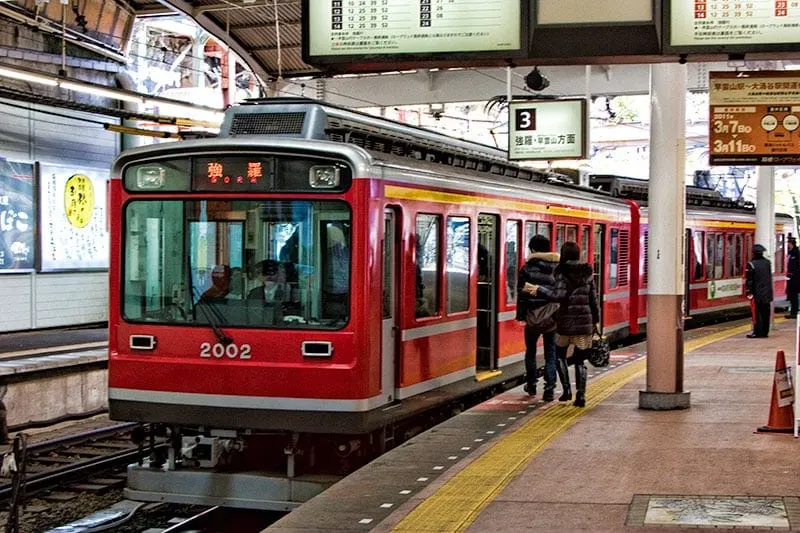
Gora to Sounzan
It’s a very short walk from the Gora Tozan train station to the cable car station. If you were going to walk from there it’s a very steep slope, especially in the winter’s snow but the cable car makes the 1.2km track a breeze in around 10 minutes. Make sure you position yourself to enjoy the view, it’s beautiful.
The cable car takes you to the boarding area for the first section of the ropeway.
The cost without the Hakone FreePass would be Y420
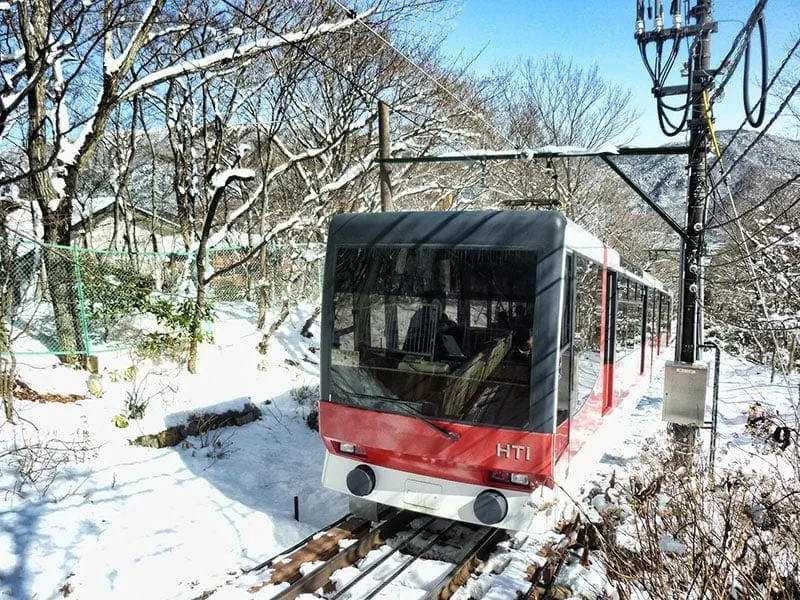
The Rope-way
There are 3 sections on the ropeway so it is a decent length ride to take a good look at the natural area and geothermal landscapes around and under you. The first section is Sounsan to Owakudani, then Owakudani to Ubako and finally Ubako to Togendai station.
Take some time at Owakudani to have a good look around. The views of Mt Fuji if you have a clear day are absolutely stunning from here. If you walk up to the geothermal area you can see where they cook the black eggs. There are large steaming vents in the mountain and pools of almost boiling water. There’s a restaurant for lunch at the top and you can buy the black eggs said to give 7 years of good luck.
The cost without the Hakone FreePass would be Y1370
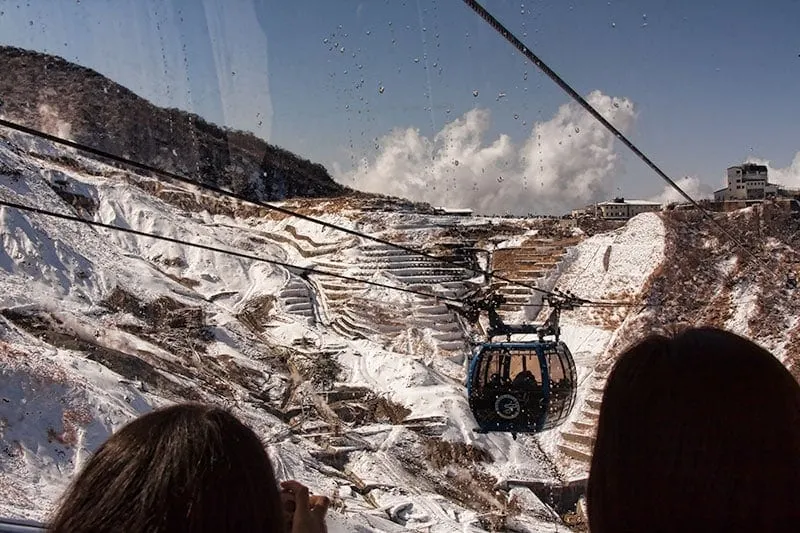
Hakone sightseeing cruise
From the last ropeway station at Togendai walk down to the edge of the lake. We spent a while walking around a park area on the edge of the lake waiting for the next sailing time. We weren’t sure about the relevance of the pirate ship on the lake but then the 1970s swan paddle boats were a bit of a mystery too. The views from out on the lake were excellent, you could see Mt Fuji and the Hakone Shrines floating torii towards the other end of the crossing.
During winter the hillside was quite bare and brown, at other times of the year you would expect to see it covered in blossom, coloured autumn leaves or greenery.
The cost without the Hakone FreePass would be Y1000
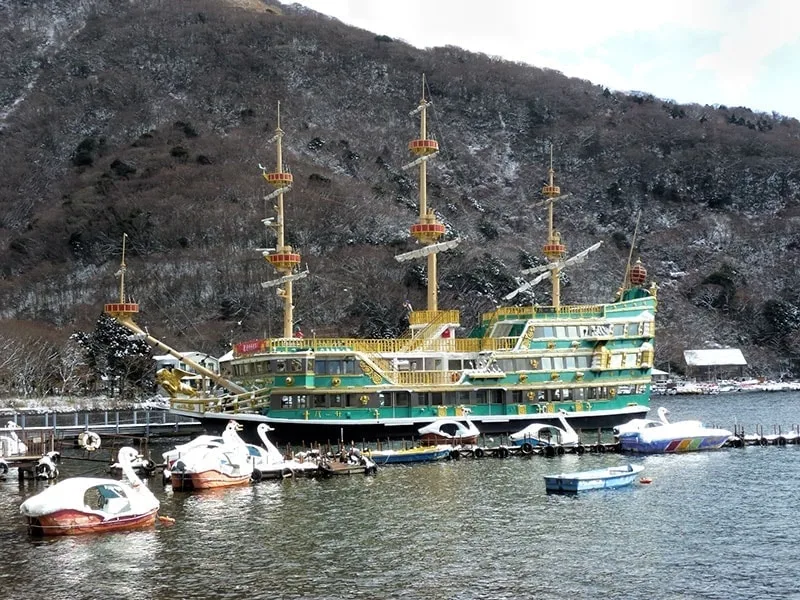
Hakone Tozan bus
We only used the bus to get back from Lake Ashi to Odawara station but there’s an extensive bus network if you’re staying in the area or want to visit attractions further out.
The bus isn’t our preferred transport in Japan, the seats are quite small, you board at the back door and they run on time so there is little patience if you’re a bit slow finding the right money. Another reason why I like to have either a day pass or a stored value card for the transport.
The cost without the Hakone FreePass for this ride would be Y960
Is the Hakone FreePass good value?
The FreePass included value for the route we took is Y4420 for a purchase price of Y4000. We did the course we planned to do and saved Y420 or 9.5%.
So we did find the pass worthwhile? While the financial saving was minimal for a day trip it was very easy to purchase the Freepass at Odawara station and it meant we didn’t need to queue for tickets or find the right change throughout the day. If collecting a pass from the Odawara Station Information Centre isn’t convenient there are also dispensing ticket machines at Odakyu stations along the line.
In hindsight, we didn’t feel the pass was a necessity for the day trip but there was no downside, it was convenient and offered a small cost saving. The cost-saving would be better for anyone either using the full round trip from Tokyo or staying in Hakone overnight and continuing their sightseeing on the second day.
Interested? You can save these images to Pinterest for later
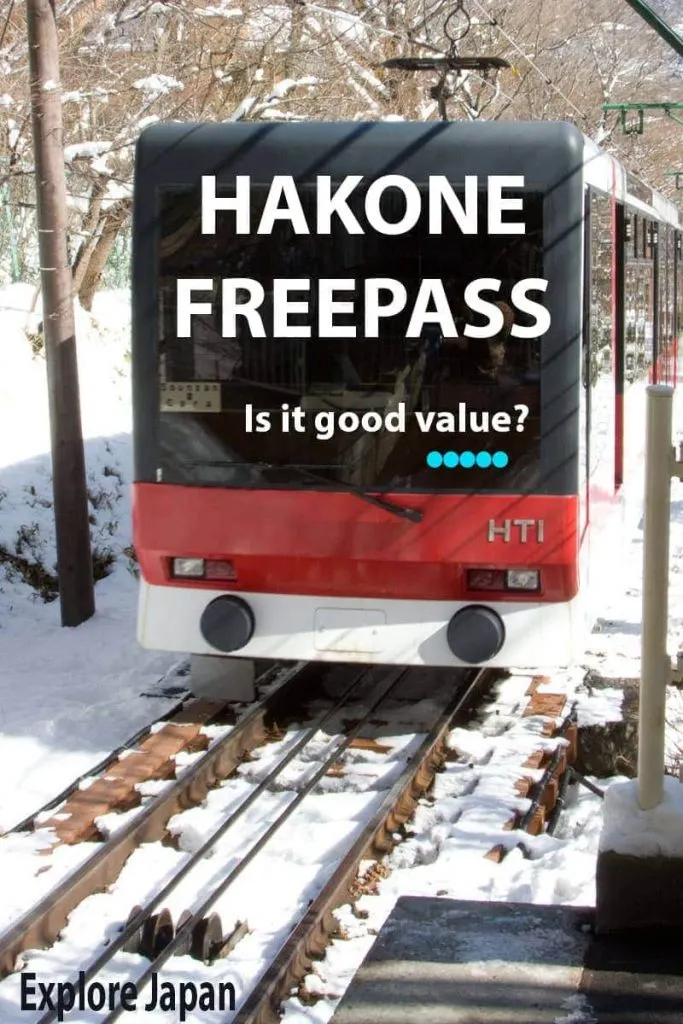
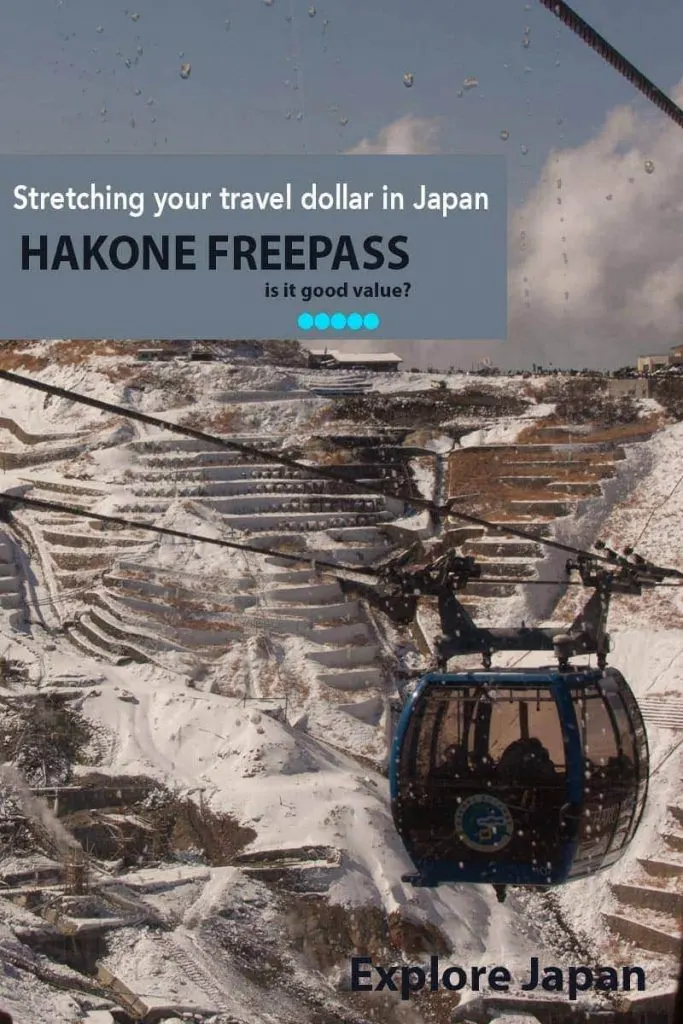
If you want to know more about what there is to see and do in Hakone, or if you’re interested in some additional information and tips for planning your trip you may also want to read our article on A Day Trip to Hakone.
If you’ve visited Hakone either using the free-pass or without, we’d love to hear your thoughts in the comments below.
Ashley Hollow
Friday 6th of March 2020
Hi there.
The info i'm trying to find that's stumping me is the cost of getting the limited express romance car for 2 people returning to Shinjuku VS getting the Hakone Freepass.
I would get the Hakone Freepass from Shinjuku, assuming that it covers the cost of going to and from Hakone via the Odakyu Line / Romance Car.
so does the Freepass cover travel to and from Hakone, or is that still an extra cost?
Cheers, and great article
Toni Broome
Friday 6th of March 2020
Hi Ashley, the wording and the way they price this on the official site is way more confusing than it needs to be. Firstly there are two main versions of the 'Hakone Freepass' one includes the return trip from Shinjuku (Y5700) or you can buy the pass in the Hakone area and that only covers that section not transport from Tokyo (Y4600). In Japan express trains generally need two tickets, the ticket for the ride and an express supplement ticket, the Shinjuku Hakone Freepass includes the ticket for the express romance car (Y1220 if you buy it separately) but NOT the express supplement ticket which is an additional Y1110 each way. I don't know why they do it this way rather than inclusive pricing but you need to add that supplement on if doing the train both ways. Overall the saving if doing the loop and return to Shinjuku is now around Y1090 for an adult, a bit higher for a child.
I hope that helps with your decision, enjoy your trip!
Des
Tuesday 28th of January 2020
Hi Nadia, We are a group travelling with 3 1year olds. Are the areas manageable with a pram especially the trek to geothermal areas in Owakudani?
Thank you, Des
Toni Broome
Monday 3rd of February 2020
Hi Des, I'm not sure Nadia will see your message but Hakone isn't particularly stroller friendly generally although if you are prepared to carry the pram and the children from time to time you could manage. The difficulty is both getting them around on the transport that's not designed for them and the lack of flat areas to wheel them. Taking 3 children in prams on the path up to the geothermal pools at Owakudani I can't see working, from memory it was narrow with people going both directions and uneven, but there was a lot of snow. This isn't a good photo but give you a bit of an idea on the walk way up - https://www.2aussietravellers.com/wp-content/uploads/2020/02/walkway-at-Owakudani.jpg
Irene
Wednesday 18th of December 2019
We will be in Japan this December for 15 days using JR Pass. Day 5-6th in Mt Fuji and day 7-8th in Hakone we have already booked an accommodation on this two places. Tokyo to Odawara using JR Pass then purchase a 3-day Fuji-Hakone Pass ....my concern is if we can possibly transfer from Odawara to Fujisan using this pass with our big luggage?
My other option which is a very expensive one is: Tokyo-Fujisan (using JR Pass + 1040 yen train fare from Otsuki to Fujisan) . I don't think i can get Fuji-Hakone Pass on this route so my plan is to get a 2-day Kawaguchiko Sightseeing Bus. On the 3rd day to Hakone: Fujisan-Odawara (using JR Pass + 1040 yen train fare from Fujisan to Otsuki), from Odawara we will explore Hakone using 2 day Hakone Free Pass.
Toni Broome
Tuesday 24th of December 2019
While fairly close as the crow flies Hakone and the Fuji 5 lakes districts are quite time-consuming to get between. Beautifully areas to visit and stay but I don't have much to add to what you have already found. Having the National Park and mountain in between them there is quite a detour by road and no train line up through the middle there. Getting to both is much easier from Tokyo. The Chuo bus does cater for luggage but other Odakyu transport in the region isn't set up for larger suitcases, especially as it nears the New Year holiday period it will be quite busy. Depending on where you are based before and after I would consider taking a smaller overnight bag and either using the forwarding service to your next location or leaving suitcases with the hotel you stayed at previously and collecting before you move on. Enjoy your visits, it should be really beautiful at this time of year.
Nadia
Monday 9th of September 2019
Hai, i am staying in Fujisawa (5 station before Odawara along Tokaido line), if im purchased hakone pass from odawara but I wont stay in Hakone, since my apato is quite close to odawara, can I still use the pass for 2 days stright?
Jo
Sunday 17th of November 2019
Did this trip last week (7 Nov 2019) - be aware that the Hakone Tozan Railway is not operating at present due to Typhoon damage. Buses operate from Odawara to Gora however there is a significant wait, equally same wait on the return. Just not enough buses. There is also no access to Owakudani, again Typhoon damage, so a straight through transit from one rope way to the other. The significant bus waiting time left very little time to explore/enjoy the stops. It also makes it a very long day trip if you are travelling from Tokyo. In saying that we had a fabulous day but if we were doing it again we would definitely plan for 2 days. Tip: Don't waste time at Odawara Train Station just get straight to the bus stop. Not sure when the Tozan Rail will be operating but it is probably worth checking.
Toni Broome
Monday 9th of September 2019
Hi Nadia, the pass is for 2 consecutive days, it's just that if you are returning to Tokyo (or Fujisawa) in between than the cost of return trip back into the Hakone pass zone will be an additional expense on the second day.
Jo Keleher
Wednesday 21st of August 2019
Hi there 2 Aussie Travellers. in the process of planning japan trip for next May - 25 days - woo hoo. I am looking at staying in the Hakone area for 2 nights and have found fab looking accommodation in Gotemba. Planning on buying either of the free passes (will have a JR Pass as well). so my question is...I understand that coming from Tokyo the JR Pass will get us as far as Odawara and then we would use the free pass to get us further afield - is that correct? and it is unlimited use of the transport available with the free pass??? I am assuming we can use this free pass to get us to our accommodation in Gotemba (or my other accommodation choice is Ashinoko near the lake) and back again to Odawara so we can continue through to Hiroshima...as well as getting us around to all the attractions the free pass covers. I originally thought we would stay in Odawara untill I started exploring the area further...an opportunity to stay closer to Fuji-San is not to be passed up me thinks... My itinerary so far is - 4 nights tokyo, 2 Hakone area, 3 Hisoshima, 5 Kyoto, 2 Kanazawa, 3 Hakodate, 3 Sendai, 2 Nikko - head to airport back to OZ... Your thoughts and advice most welcome. Cheers Jo
Toni Broome
Sunday 25th of August 2019
Hi Jo. Yes if your JR pass is active I would use that to Odawara and then use the local Hakone free pass to get around as much as you want (within the route) when you are there. You can use each transport option as much as you want to. Gotemba is most popular if you want to go to the shopping outlets because it's a bit off the scenic loop but you can get there by bus with the pass, personally, I love the view of Fuji over the lake (when the clouds are behaving).
Your trip sounds fantastic,May is a lovely time of year to go, everything is green and flowering again after the winter browning off and it's a good temperature for travelling